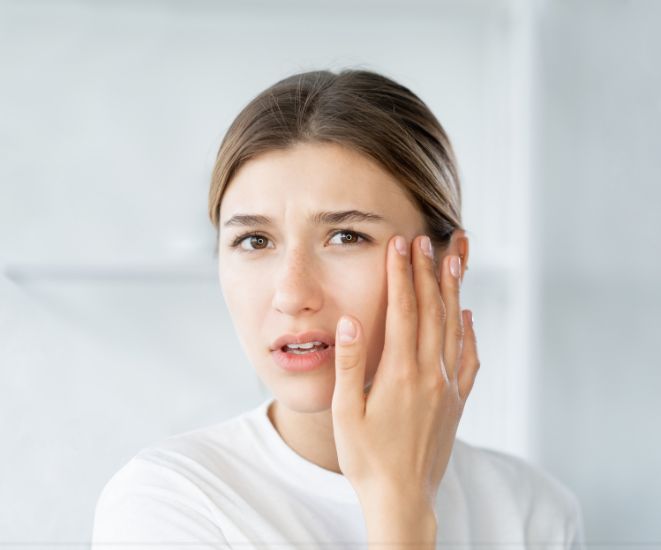Seeing Clearly
Recognizing the signs of dry eye is important, as it allows you to seek treatment and improve your eye health. To help, there's Cequa, a prescription eye drop that helps increase tear production.
10 Dry Eye Signs
1. Burning or Stinging Sensation
One of the most noticeable signs of dry eye is a burning or stinging feeling in your eyes. This sensation can be annoying and distracting, making it hard to focus on daily activities such as reading or using a computer.
2. Itchy Eyes
If you often find yourself scratching or rubbing your eyes, you may be experiencing dryness. Itchy eyes can lead to irritation, and rubbing them can worsen the discomfort. It's important to resist the urge to rub your eyes to avoid further irritation.
Related Search Topics (Ads)
3. Excessive Tearing
Interestingly, dry eyes can sometimes result in excessive tearing. When your eyes lack moisture, your body may produce more tears to compensate. However, these tears may not be of the right quality to provide comfort, leading to watery eyes without relief.
4. Redness
Many individuals with dry eye syndrome notice redness in their eyes. This happens due to irritation and inflammation caused by insufficient lubrication. Red eyes can make you appear tired or unwell.
5. Blurred Vision
Blurred vision is another symptom of dry eye. This occurs when there isn’t enough moisture on the surface of your eyes to focus clearly. The blurriness may fluctuate and can become more noticeable after long periods of reading or looking at screens.
6. Eye Fatigue
You might experience tiredness in your eyes, especially after extended screen time or reading. This fatigue is often due to the extra effort your eyes exert to remain comfortable when they are dry.
7. Sensitivity to Light
If you find bright lights or sunlight uncomfortable, you might be experiencing light sensitivity, which is often linked to dry eye syndrome. This sensitivity can make outdoor activities or well-lit spaces challenging.
8. Gritty Feeling
Some people describe a gritty or sandy sensation in their eyes, as if there is something stuck in them. This feeling can be irritating and can lead to frequent blinking in an attempt to relieve the discomfort.
9. Difficulty Wearing Contact Lenses
For those who wear contact lenses, dry eyes can cause discomfort and make it challenging to wear them. You might find your lenses feel uncomfortable or as if they are moving around in your eyes.
10. Eye Discharge
In some cases, dry eyes can lead to a thick, yellowish discharge. This occurs when your eyes attempt to compensate for dryness. If you notice unusual discharge, it’s important to consult with a healthcare professional.
Treatments for Dry Eye
If you experience any signs of dry eye syndrome, there are several treatment options available to help relieve your symptoms and improve your comfort:
- Artificial tears: Over-the-counter artificial tears can help lubricate your eyes. It’s best to choose preservative-free drops, especially if you plan to use them frequently.
- Prescription eye drops: If artificial tears don’t provide relief, your doctor may prescribe medications such as cyclosporine (Cequa) to reduce inflammation and stimulate tear production.
- Warm compresses: Applying a warm compress to your eyes can soothe discomfort and encourage tear production. Just soak a clean cloth in warm water, wring it out and place it over your closed eyes for several minutes.
- Punctal plugs: In some situations, your doctor may recommend punctal plugs, small devices inserted into your tear ducts to help retain tears on the surface of your eyes for longer periods.
- Lifestyle changes: Making simple changes can improve dry eye symptoms. For example, taking regular breaks from screens, staying hydrated and avoiding smoke can be beneficial.
- Humidifiers: Using a humidifier in your home can add moisture to the air, which can reduce dryness in your eyes, especially during winter months when indoor air tends to be drier.
- Omega-3 fatty acids: Incorporating omega-3 fatty acids into your diet, found in fish or supplements, may help improve tear production and reduce dry eye symptoms.
- Avoiding allergens: Identifying and avoiding allergens that irritate your eyes can help reduce dry eye symptoms caused by environmental factors.
- Sunglasses: Wearing sunglasses outdoors can protect your eyes from wind and bright sunlight, helping to keep them moist and comfortable.
- Regular eye exams: Visiting your eye doctor regularly is crucial for monitoring your eye health and determining the best treatment options for your specific needs.
- Cequa: Cequa is a prescription eye drop contains cyclosporine and helps reduce inflammation in the tear glands. It’s usually applied twice daily and can take several weeks to show results.
Maintaining Good Eye Health
Recognizing the signs of dry eye is essential for maintaining good eye health. If you notice any of these symptoms, consider reaching out to an eye care professional to explore treatment options. With the right care and attention, you can manage dry eye syndrome effectively and improve your comfort in daily life.
Learn more about the signs of lymphoma.

